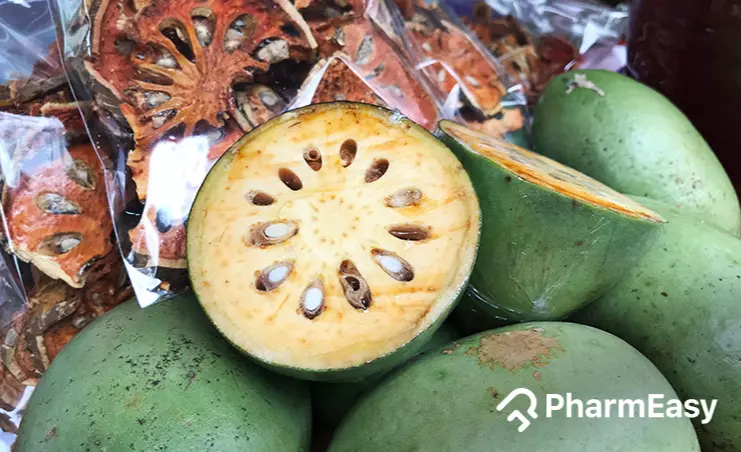Bael (Aegle Marmelos): Uses, Benefits, Nutritional Value & Side Effects By Dr. Siddharth Gupta
By Dr Siddharth Gupta +2 more

Get,

to manage your symptom
Get your,


4 Cr+ families
benefitted

OTP sent to 9988776655



You’ve successfully subscribed to receive
doctor-approved tips on
Whatsapp

Get ready to feel your best.

Hi There,
Download the PharmEasy App now!!


Register to Avail the Offer
Send OTPBy continuing, you agree with our Privacy Policy and Terms and Conditions

Hi There,
Sign up on PharmEasy now!!
Trusted by 4 crore+ families

OTP sent to 9988776655



You have unlocked 25% off on medicines




Code: NU25
By Dr Siddharth Gupta +2 more
Table of Contents
The Bael tree is considered a sacred tree in Indian tradition. Its leaves are often used in religious rituals and offered in prayers. It is known by many regional names: Adhararutha in Sanskrit, Iyalbudi in Tamil, Sriphalamu in Telugu, Billi in Gujarati, Bengal quince or stone apple in English and Bel in Hindi and Bengali1. Its scientific name is Aegle marmelos, and is believed to be one of the most important medicinal plants in India, Ceylon, and Burma2.
”No drug has been longer and better known nor more appreciated by the inhabitants of India than the Bael fruit,” said Chopra in his book, Indigenous Drugs of India (1982). Bael has been used in Ayurveda as a part of various formulations since ancient times to help with boils, dysentery, earaches, discharge from ears and fever/cold2.

Bael fruit is a nutrient-rich food that provides a variety of essential vitamins and minerals. According to available data, its nutritional composition includes3:
Other than these nutrients, it also contains various essential amino acids, vitamins B1 and B2, and phytochemicals. It is observed that Bael contains the highest amount of alkaloids, flavonoids, and tannins compared to other medicinal plants4.
Bael has various properties, and it might play a role in helping with many diseases. It might possess the potential properties such as5:
Bael might have the following potential uses:
According to animal studies6, oral intake or injection of Bael fruit extract might help to lower blood glucose and haemoglobin-bound glucose levels. It might also help increase the level of insulin in the blood and might help the conversion of glucose in the liver. Certain compounds (coumarins) present in the bael fruit extract might help in the secretion of insulin from the liver and thus might be helpful in lowering blood sugar levels.
Furthermore, as per a clinical trial2, lowering of blood cholesterol and a slight lowering of blood glucose might be possible in some patients with diabetes to whom Bael leaf extract was administered. However, more research is required. Kindly consult a doctor for serious conditions such as diabetes, which must be diagnosed and treated by a doctor.
Bael might have stomach protective effects. Stomach ulcers are mainly formed due to the accumulation of free radicals in the stomach cells (oxidative stress). Bael might exhibit antiulcer properties through its potential antioxidant activity and might eliminate the oxidative stress in the stomach lining and ulcer formation7. Additionally, the unripe Bael fruit might help with the damage to the stomach lining induced by absolute ethanol (alcohol) in the stomach2. However, more research is required. Kindly consult a doctor. Please do not self-medicate.
Based on my experience, I have seen positive effects of Bael fruit in the management of ulcer disease. The fruit contains certain compounds that have been found to possess anti-ulcer properties, which may help in reducing the symptoms of ulcers10.
Dr. Rajeev Singh, BAMS
Bael extracts might help in the reduction of swelling, pain, and fever. The alcoholic extract of Bael leaves might potentially inhibit the activation of a receptor (histamine receptor), which is responsible for inflammation and most of the symptoms of allergy and asthma2. However, more research is required and you should consult a doctor before using Bael for health.
In one of the studies8, the administration of Bael has shown the potential to interfere with the growth of a tumour. The exact mechanism has not yet been established, but the alcoholic extract of Bael might have the potential to help against the growth of cancer cells. A bioactive compound present in the leaf extract of Bael might show the potential to interfere with the growth of breast cancer cells8. However, more research is required. Cancer is a serious condition and must be diagnosed and treated by a doctor.
Bael might be effective for various infections caused by bacteria, indicating that it might act as a potent antibacterial agent2.
Studies9 have shown that the 50% ethanolic extract of Bael might have an effect on the Ranikhet disease virus. It might also act on the early activities of the virus in the body and may stop it, which is in contrast to the activity of modern drugs being used to treat viral diseases.
Furthermore, Bael leaf oil may show a protective effect against fungal infections.This activity may be due to its interference with the mechanism that leads to the growth of fungus in the body. Various studies9 have shown that it might have effectiveness against common fungal infections. However, more research is required to ascertain such claims.
The root extract and the unripe fruit pulp of Bael might help with diarrhoea. This potential use has been mentioned even in ancient Indian texts. It may be due to its potential effect against various bacteria causing stomach infections9. However, more studies are required. Kindly do not self-medicate.
I have observed that the Bael fruit has been traditionally used for the management of jaundice. Bael contains compounds that help in improving liver function and promoting the elimination of toxins from the body. These properties of Bael may support the recovery from jaundice and help in restoring normal liver function10.
Dr. Siddharth Gupta, B.A.M.S, M.D (Ayu)
Though there are studies that show the potential use of bael in various conditions, these are insufficient and there is a need for further studies to establish the true extent of the benefits of bael on human health.
Based on the recommendations from nutrition scientists, it is advised to include a minimum of 115 grams of bael fruit in your daily diet for a balanced nutrition. This fruit is rich in essential nutrients that can support optimal growth and development of the human body. By providing the necessary nutrients, bael fruit can promote overall health and well-being10.
Dr. Smita Barode, B.A.M.S, M.S.
Bael is a traditional medicinal plant, and all of its parts are utilised for their various therapeutic properties. The parts that can be used are:
Your Ayurvedic physician will prescribe you the form and dosage as per your health condition.
You must consult a qualified doctor before taking any herbal supplements. Do not discontinue or replace an ongoing treatment of modern medicine with an ayurvedic/herbal preparation without consulting a qualified doctor.
It is a traditional recipe commonly found in the households of North Eastern India, especially during summer.
Here’s a simple way to prepare it:
Also Read: Harad: Uses, Benefits, Side Effects, and More!
Now that you understand the benefits of Bael. Let’s look at some easy Bael recipe ideas you can try out:
Get all the benefits of bael with these tasty recipes. Don’t be afraid to venture outside your comfort zone, while bael juice recipes may be easy, there are so many other ways to consume this fruit!
There are no common side effects reported with the use of Bael. However, if any kind of side effect is noticed, a physician should be consulted for expert opinion.
You should ensure to take general precautions before using bael for its potential health uses, especially by pregnant women, breastfeeding mothers, elderly individuals, and children. However, an Ayurvedic physician should be consulted for its use in specific conditions, as the physician will prescribe the appropriate dosage and form.
Also Read: Multani Mitti: Uses, Benefits, Side Effects & More!
More research is required to study the interactions of bael with other drugs. Therefore, precautions should be taken and a doctor should be consulted to ensure the safety of using bael for any conditions. Please do not self-medicate, alter, replace or discontinue any ongoing treatment by yourself.
Also Read: Bottle Gourd (Lauki): Uses, Benefits, Side Effects and More!
There are no published reports suggesting the benefit of bael for hair.
Bael leaves might have potential properties and may help with elevated blood sugar levels, blood cholesterol levels, various infectious diseases, etc. However, more studies are required to prove such claims. Kindly consult a doctor for proper diagnosis and treatment of conditions.
Patients with diabetes may be able to consume bael. It might help lower blood sugar levels and might have anti-diabetic properties. However, more studies are required to prove such effects of bael.
No reports regarding the usage of bael as a cure for cataracts have been documented. Please consult a doctor.
Disclaimer: The information provided here is for educational/awareness purposes only and is not intended to be a substitute for medical treatment by a healthcare professional and should not be relied upon to diagnose or treat any medical condition. The reader should consult a registered medical practitioner to determine the appropriateness of the information and before consuming any medication. PharmEasy does not provide any guarantee or warranty (express or implied) regarding the accuracy, adequacy, completeness, legality, reliability or usefulness of the information; and disclaims any liability arising thereof.
Comments

Leave your comment...
You may also like
Comments